An epicurean adventure to: Tunisia
Boy oh boy, this Tunisian orange and almond cake is something to behold!
This is truly an indulgent cake fit for royalty. Bursting with flavours, tonnes and tonnes of flavours! It's perfectly moist, slices beautifully and you can dress it up to the nines.
It tastes like sunshine. Every bite behaves like a good whisky where you have layer upon layer of flavour surprises, like orange, lemon, cinnamon, cloves and star anise.
The good news is, it's an incredibly easy-to-make cake recipe. The biggest task is probably zesting the oranges and lemons, but other than that, you don't even have to switch on an electric mixer. The orange and almond cake is drenched in a spicy, citrussy syrup that will transport you right into the heart of vibrant Tunisia.

Jump to:
- Fast facts - Tunisia
- What's to love about this recipe
- Key ingredient notes and substitutions
- How to make Tunisian orange cake
- Tips and tricks
- How to serve Tunisian cake
- Storage
- Can you freeze Tunisian cake?
- Make it gluten-free
- More recipes from the African continent
- More fruity recipes
- More Spicy Bakes
- Recipe
- More Mediterranean recipes
Fast facts - Tunisia

| Location | Tunisia is located in North Africa, bordered by the Mediterranean Sea to the north and east, Algeria to the west and Libya to the southeast. |
| Language | The official language of Tunisia is Arabic. |
| Population | Circa 11.8 million people. |
| Trivia | Tunisia has been a popular filming location for Star Wars movies, with its Saharan landscape featuring iconic sets like the village of Tataouine, which doubled as Luke Skywalker's home planet, Tatooine, in the original 1977 film. |
What's to love about this recipe
- Ultra-flavourful and a great showcase for North African and Tunisian cuisine.
- Moist and tender.
- Luxurious tasting, ideal for a special occasion.
- Easy to make.
- This Tunis cake, as it's also known, can be served with various toppings.
- Can easily be made gluten-free by swapping the panko breadcrumbs for gluten-free breadcrumbs.
- No orange blossom water is needed for this orange almond cake, all the flavour comes from fresh oranges and lemons.
Key ingredient notes and substitutions
**Please see the recipe card at the bottom of this post for the full list of ingredients.
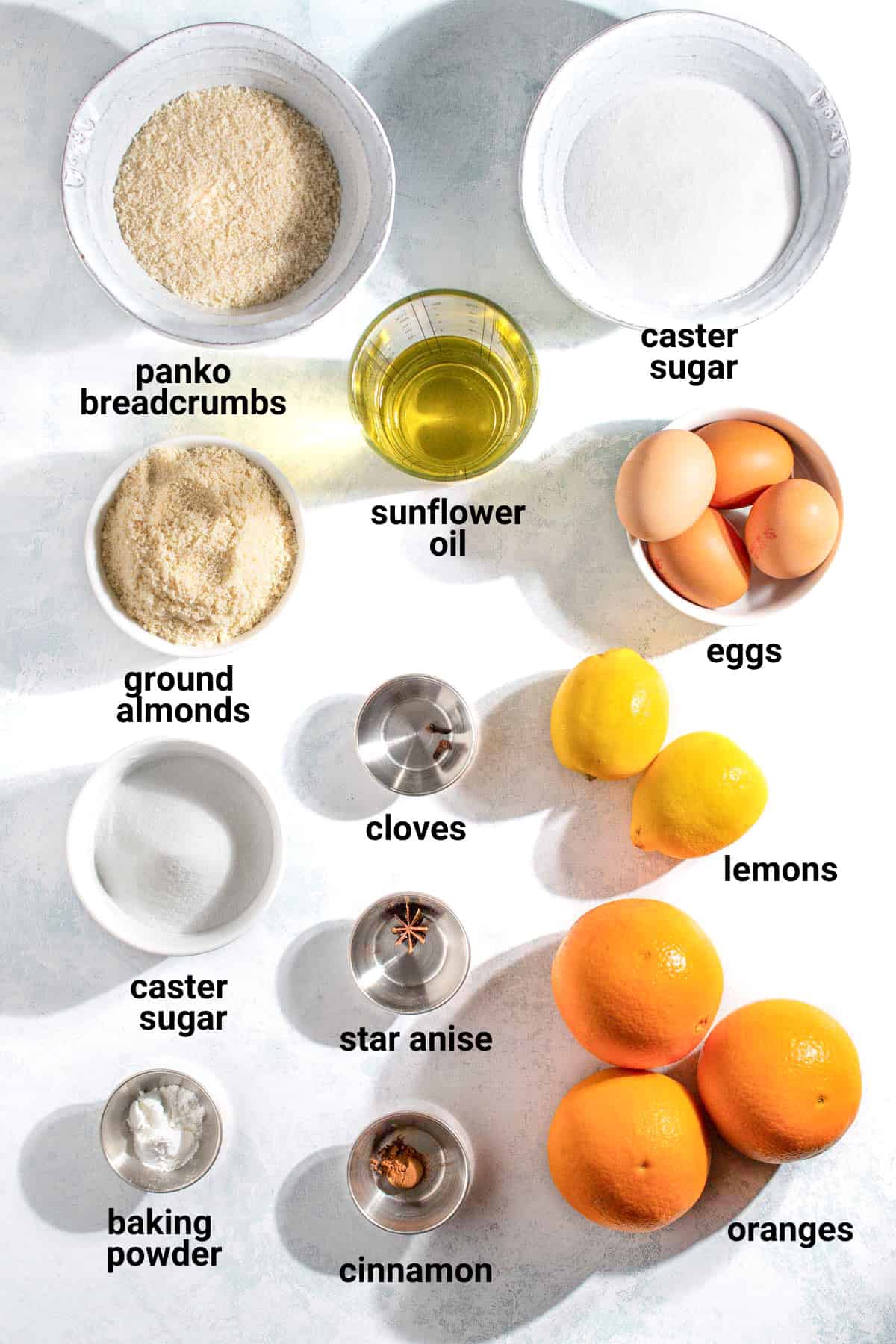
Caster sugar
Using caster sugar instead of granulated sugar in a Tunisian cake can make the cake texture smoother and more tender.
Caster sugar dissolves easily and blends well with the batter, resulting in a more evenly sweetened cake.
If you haven't got caster sugar where you are, you can easily make your own by whizzing granulated sugar in a food processor until it's somewhere between the consistency of granulated sugar and powdered/icing sugar.
Panko breadcrumbs
Panko breadcrumbs work well for this recipe as their consistency is ideal for the cake. You can typically find them in the Asian food aisle of most grocery stores.
Alternatively, you can make your own breadcrumbs if preferred.
For a gluten-free version, you can create your own breadcrumbs by processing gluten-free bread slices in a food processor. Alternatively, you can substitute the breadcrumbs with polenta for a gluten-free alternative.
Ground almonds
Ground almonds, also known as almond meal, are coarsely ground almonds.
They can be found in the baking aisles and should not be confused with flaked almonds or almond flour, as almond flour has a finer texture.
The spices
You will need two cloves, one star anise and some ground cinnamon. You can replace the ground cinnamon with a cinnamon stick.
How to make Tunisian orange cake
To make the cake
- Do not preheat the oven. The cake goes into a cold oven to help with even rising.
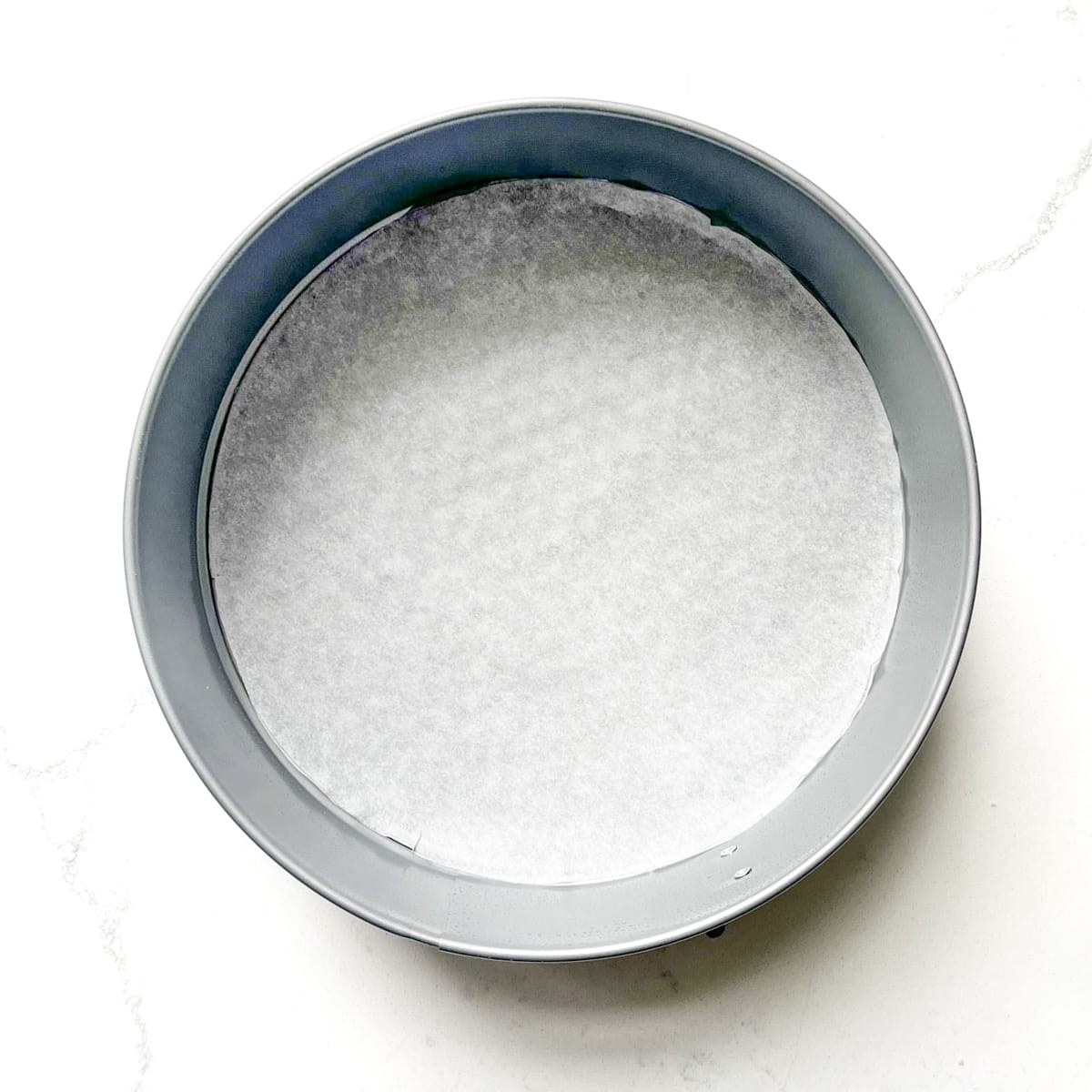
- Line a 20cm/8" springform tin with parchment paper.
Note: We only line the bottom of the cake tin and that seems to be sufficient. If you have a cake tin that tends to stick, line it entirely or use a non-stick spray/smidgen of butter.
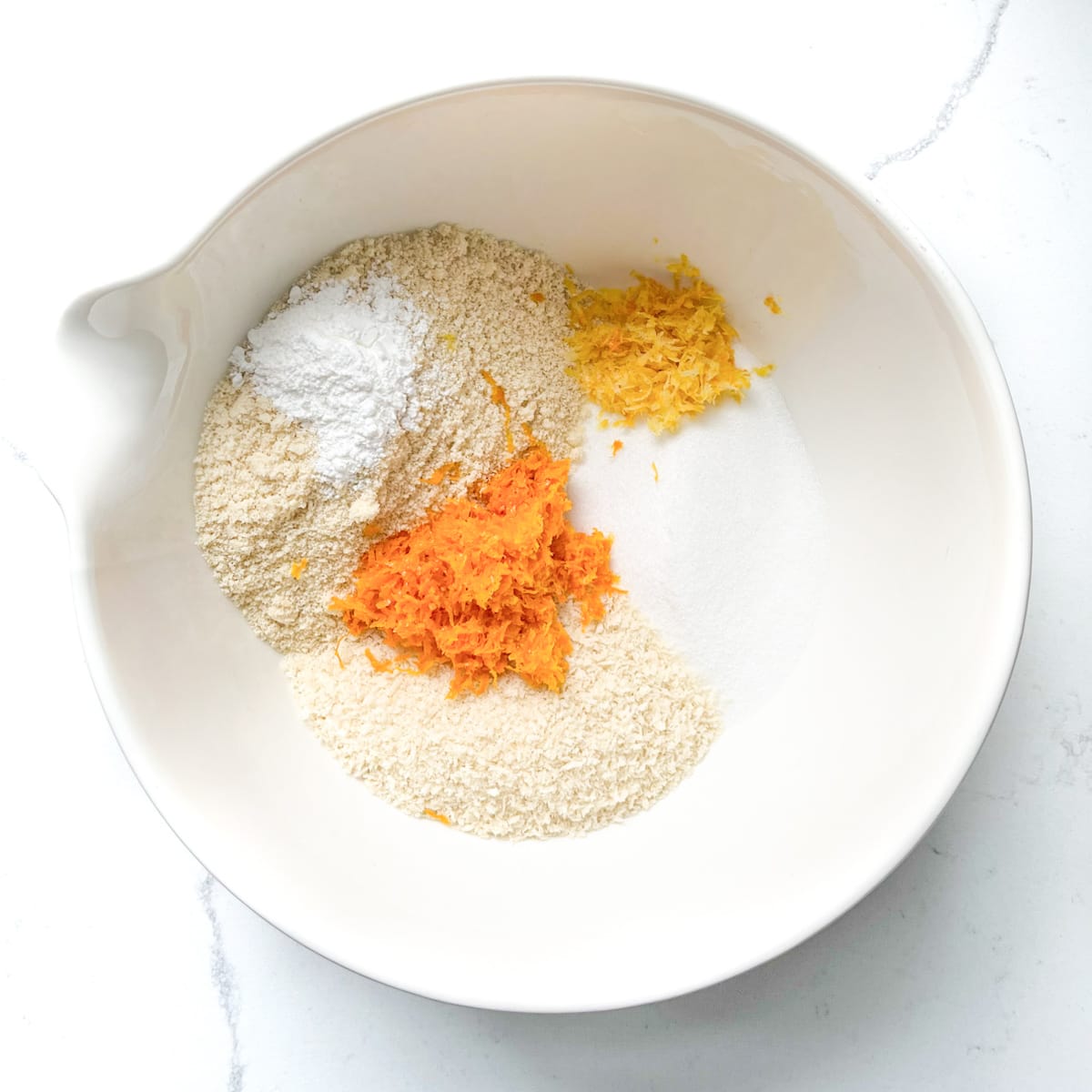
- In a large bowl, add the 200g caster sugar, panko breadcrumbs, ground almonds, baking powder, orange zest and lemon zest.
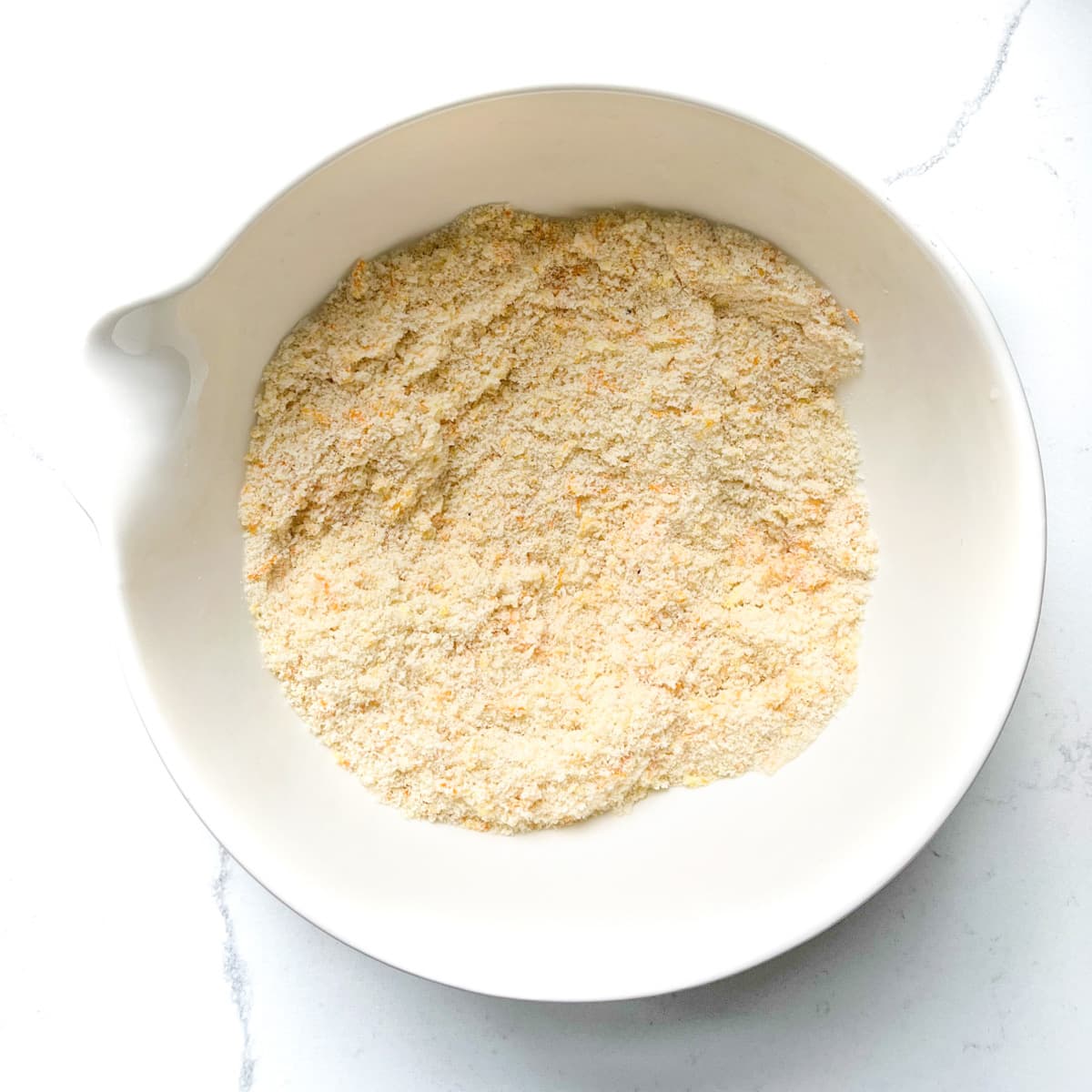
- Stir the dry ingredients together. If the zest forms little clumps, break it up with your spoon/spatula as you combine the ingredients.
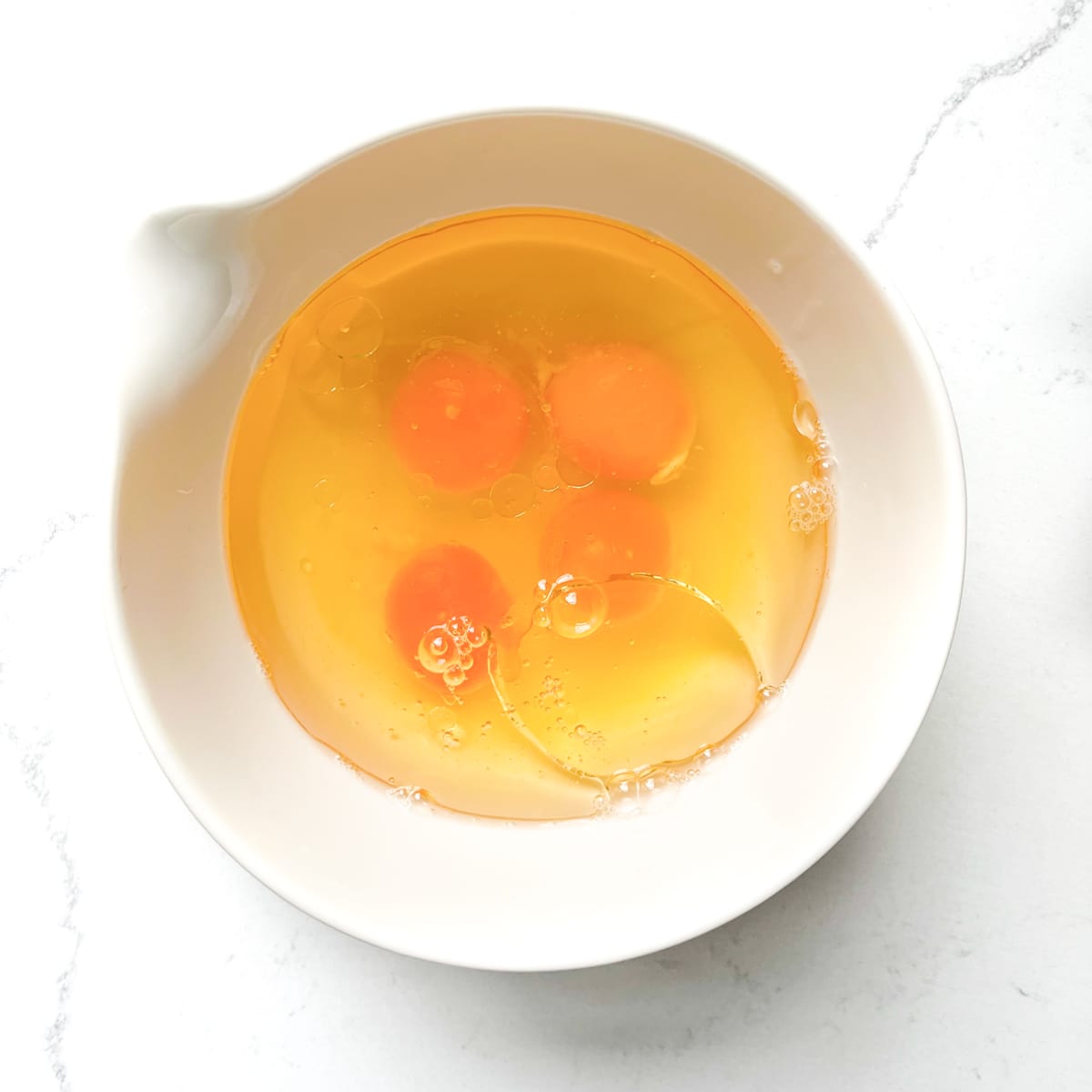
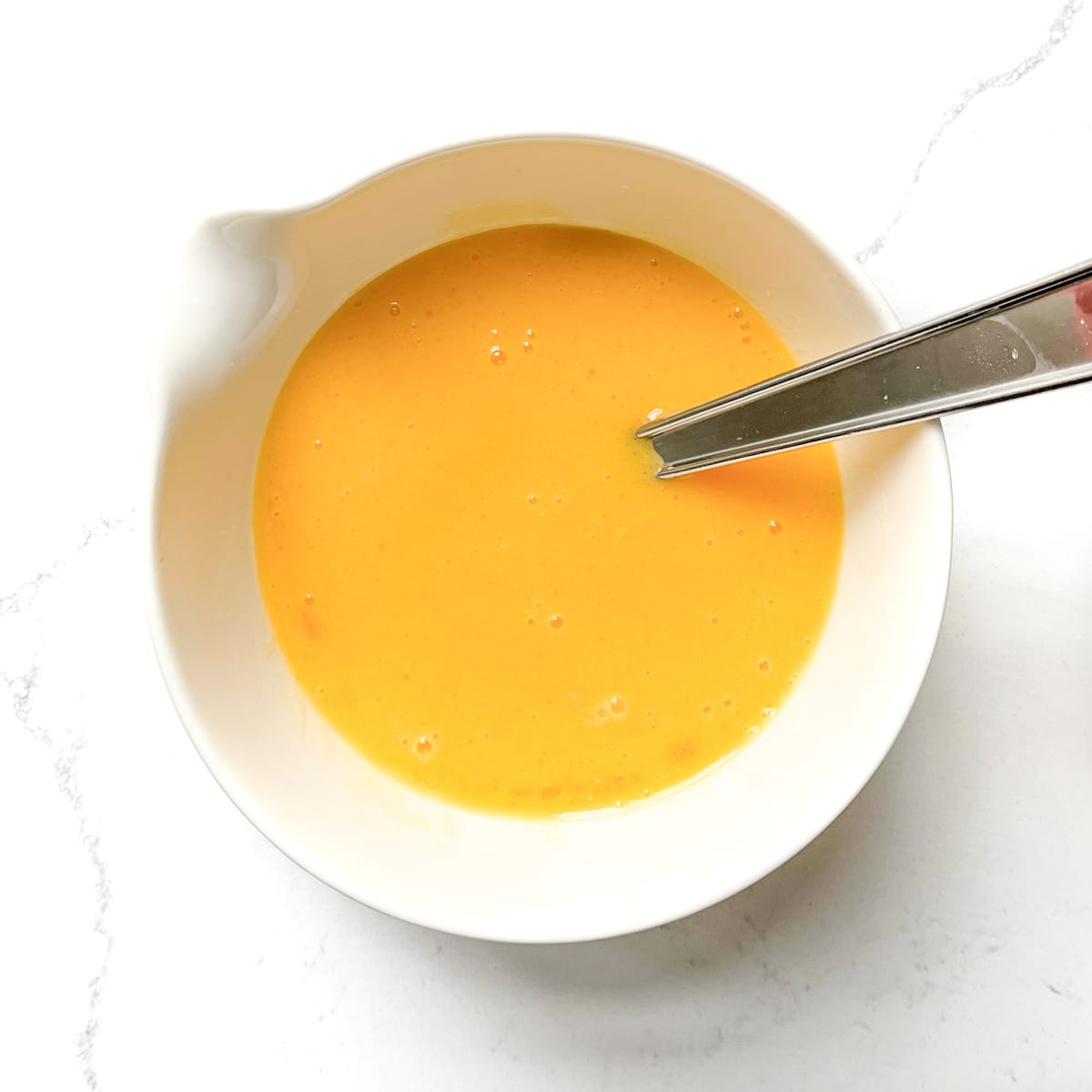
- In a separate small bowl, whisk together the eggs and vegetable oil by hand.
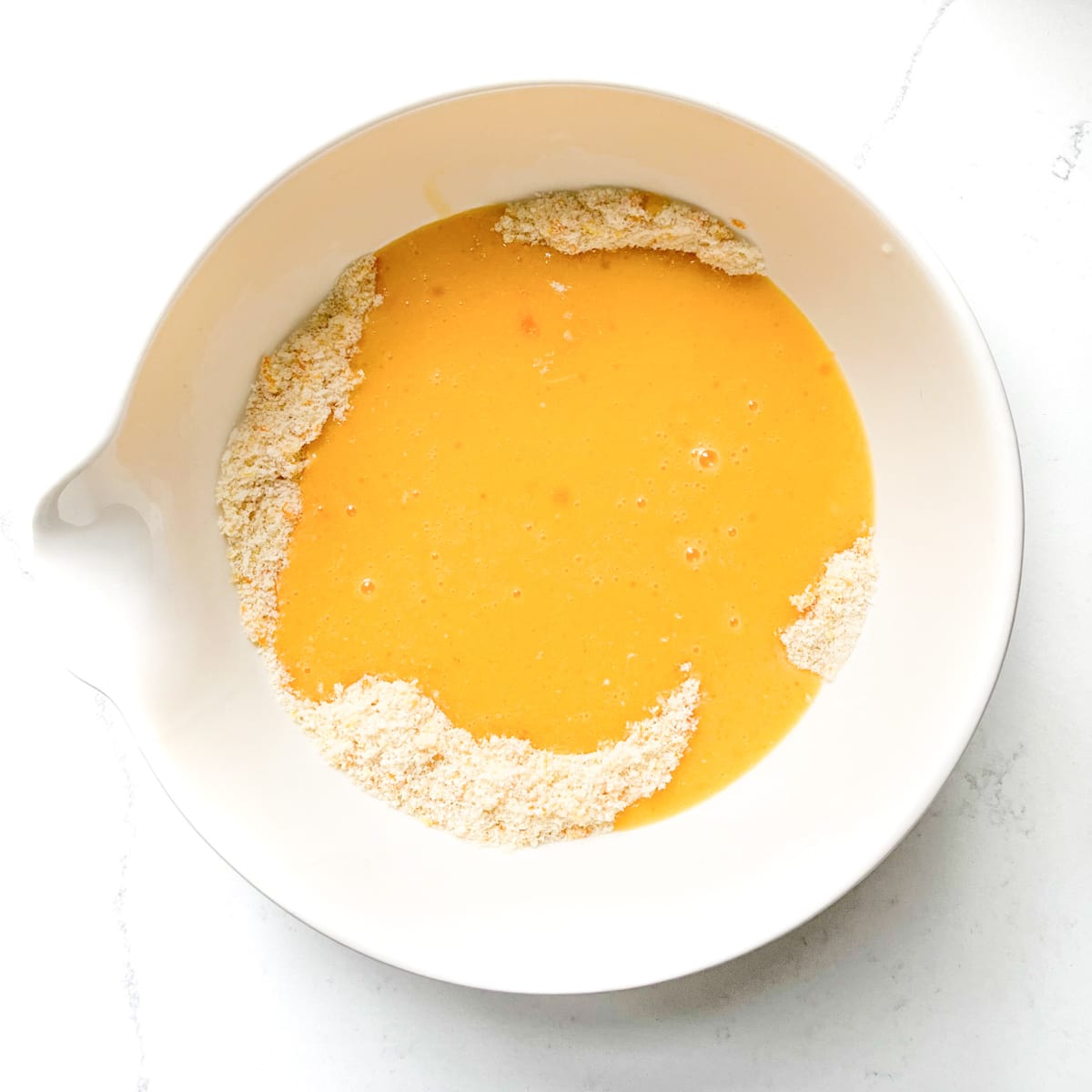
- Add the egg mixture to the dry ingredients and fold together. You'll only need a wooden spoon or spatula, not a whisk.
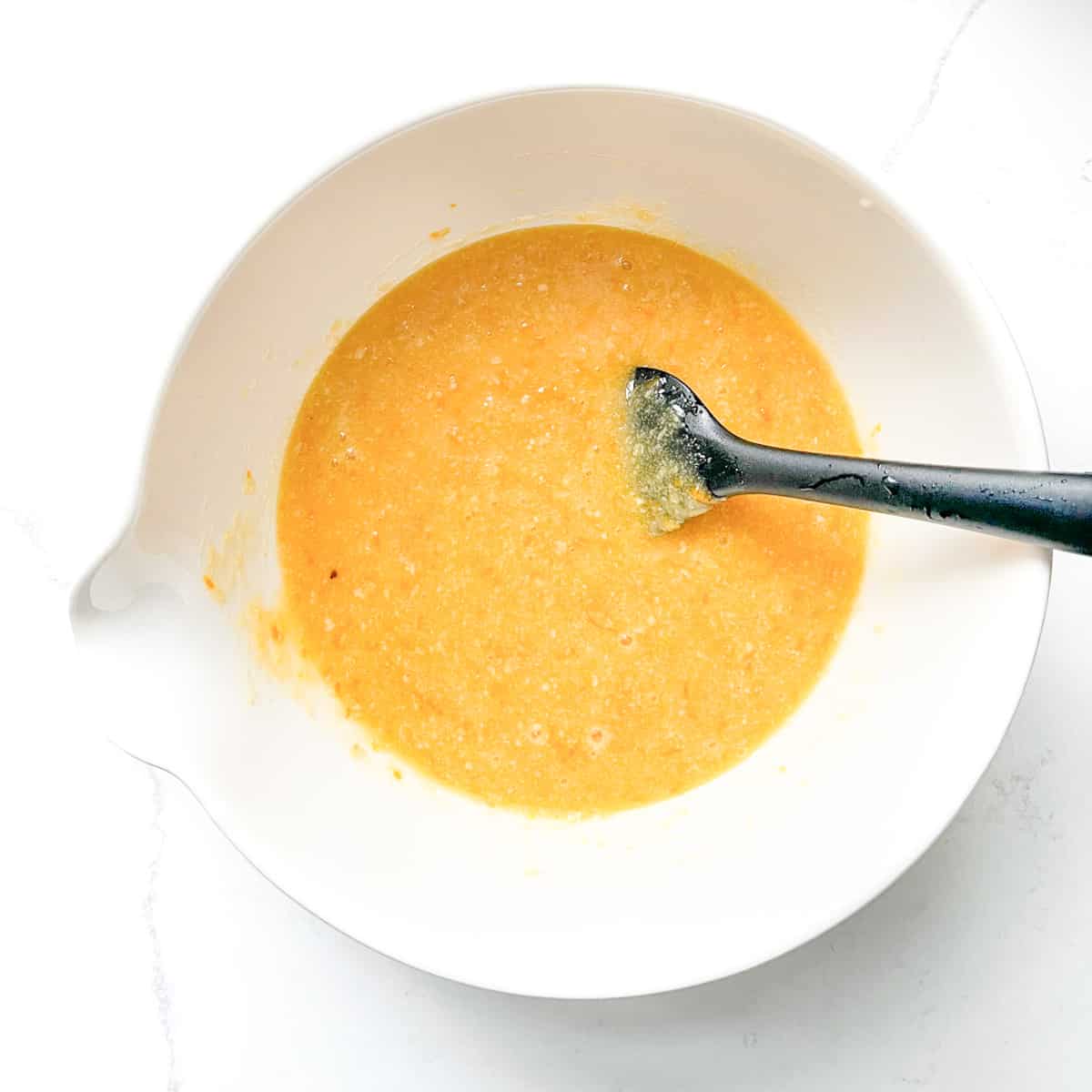
- Ensure you get all the dry ingredients lurking at the bottom of the bowl too.
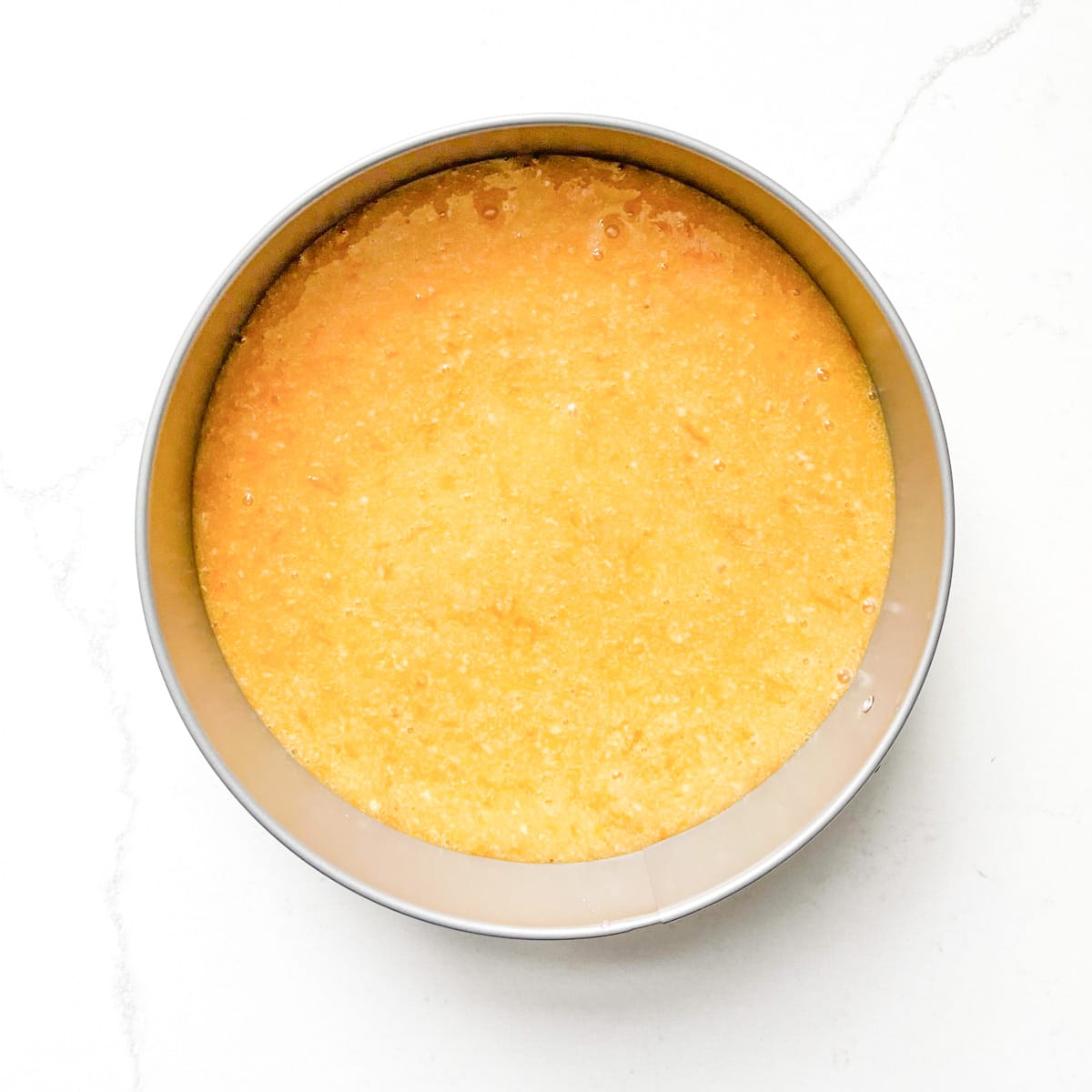
- Pour the cake batter into the prepared cake tin.
- Place the cake tin into the cold oven and turn the oven on to 180℃/356℉/gas mark 4.
- Bake for approximately 45 minutes, or until a cake tester comes out clean and the top of the cake is a rich golden brown. The baking time may vary slightly depending on your oven.
- Allow the cake to cool in the tin for about 10 minutes. To remove the cake tin's collar, gently run a palette knife along the sides of the cake to loosen it if needed.
To make the citrus syrup
- About 10 minutes before the cake is done baking, you can start making the sauce.
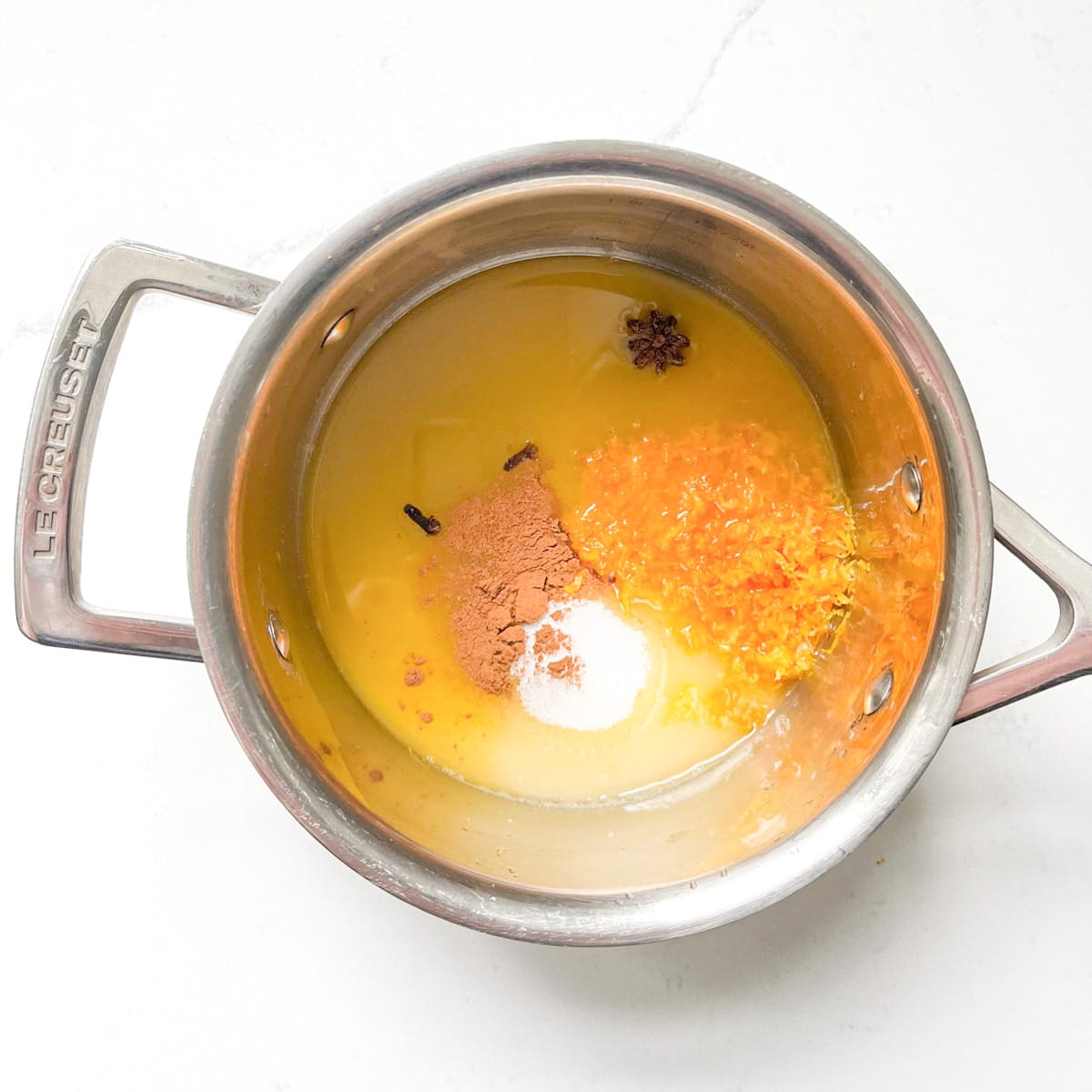
- Add all the ingredients for the sauce to a small saucepan - orange juice, lemon juice, zest, sugar and spices.
- Place the saucepan over medium heat and stir the sauce continuously to help the sugar melt. Once the mixture comes to a gentle simmer, let it simmer for an additional 3 minutes on low heat, stirring occasionally.
When the sauce has thickened slightly and has a syrupy consistency, remove it from the heat.
- After removing the collar from the cake tin, carefully transfer the cake to a large plate. Take a toothpick or a thin sharp object and poke a few holes in the top of the cake.
- Remove the cloves and star anise from the sauce. Pour the hot syrup over the cake, making sure to cover the entire surface, including the edges.
- Allow the sauce to fully absorb into the cake and for the cake to cool before serving.
Tips and tricks
To get a flawless top
Once you've taken the cake out of the tin, you can turn it upside down so that the bottom becomes the new top. This will give you a flawless, smooth surface for adding decorations.
When to add the sauce
Don't pour the sauce over the cake until you have the cake on it's serving plate. The sauce will make the cake very moist and soft, making moving it without any damage more difficult.
Easy zesting
If you don't enjoy zesting, try this trick: Rest your hand holding the zester on a chopping board and move the fruit up and down over it with your other hand.
This makes zesting faster, steadier and more consistent compared to holding the zester in the air.
Neat orange slices for decoration
If you have a mandolin, it's great for slicing the oranges for decoration. It's easier and gives you neat, thin slices.
How to serve Tunisian cake
- You can decorate the cooled cake with slices of orange, especially blood orange, to make it look beautiful.
- Sprinkle the cake with chopped pistachio nuts or any other nuts you like.
- Add marzipan decorations and holly leaves if you're doing it for Christmas.
- Drizzle with chocolate ganache.
- Serve with a dollop of crème fraîche, Greek yoghurt, mascarpone, mascarpone whipped cream or plain whipped cream.
- Serve with ice cream.
- Goes fantastic with a cup of well-brewed coffee.
Storage
The cake can be stored in an airtight container like a cake tin or plastic box for up to three days.
You can make this cake a day ahead. It stays moist and tastes just as good the next day.
Can you freeze Tunisian cake?
You can freeze Tunisian cake, but we don't recommend it. The high moisture content in the sponge may result in a soggy texture when thawed. It's best enjoyed fresh.
Make it gluten-free
To make this cake gluten-free, you can substitute the breadcrumbs with gluten-free breadcrumbs or use polenta as an alternative.
More recipes from the African continent
More fruity recipes
Apple sponge cake with streusel topping
Watermelon fresh fruit lollies
Raspberry blondies with white chocolate
Tarte aux fruits - French fruit tart
Mixed berry no-bake cheesecake
Apple crumble tart with condensed milk
Recipe

Tunisian cake
Equipment
- 1 20cm/8" springform cake tin
Ingredients
For the cake
- 200 grams caster sugar
- 50 grams panko breadcrumbs
- 100 grams ground almonds
- 1½ teaspoons baking powder
- 2 oranges, only the zest of
- 1 lemon, only the zest of
- 4 large eggs
- 200 millilitre sunflower oil
For the sauce
- 1 orange, juice and zest of
- ½ lemon, juice and zest of
- 80 grams caster sugar
- 2 whole cloves
- 1 star anise
- ¼ teaspoon ground cinnamon
Instructions
To make the cake
- Do not preheat the oven. The cake goes into a cold oven to help with even rising. Line a 20cm/8" springform cake tin with parchment paper. Note: We only line the bottom of the cake tin and that seems to be sufficient. If you have a cake tin that tends to stick, line it entirely or use a non-stick spray/smidgen of butter.
- In a large mixing bowl, add the 200g caster sugar, panko breadcrumbs, ground almonds, baking powder, zest from two oranges and zest from one lemon.200 grams caster sugar, 50 grams panko breadcrumbs, 100 grams ground almonds, 1½ teaspoons baking powder, 2 oranges, only the zest of, 1 lemon, only the zest of
- Stir the dry ingredients together. If the zest forms little clumps, break it up with your spoon/spatula as you combine the ingredients.
- In a separate bowl, whisk together the eggs and oil by hand.4 large eggs, 200 millilitre sunflower oil
- Add the oil and eggs to the dry ingredients and fold together. Ensure you get all the dry ingredients lurking at the bottom of the bowl too.
- Pour the mixture into the prepared cake tin.
- Place the cake tin into the cold oven and turn the oven on to 180℃/356℉/gas mark 4.
- Bake for 45 minutes, or until a cake tester comes out clean and the cake is golden brown on top.
- Let the cake cool in the tin for 10 minutes before removing the cake tin's collar.
To make the sauce
- About 10 minutes before the cake is done baking, start the sauce.
- Add all the ingredients for the sauce to a small saucepan.1 orange, juice and zest of, ½ lemon, juice and zest of, 80 grams caster sugar, 2 whole cloves, 1 star anise, ¼ teaspoon ground cinnamon
- Place the saucepan over medium heat and stir the sauce continuously to help the sugar melt. Once the mixture comes to a gentle simmer, let it simmer for an additional 3 minutes on low heat, stirring occasionally. When the sauce has thickened slightly and has a syrupy consistency, remove it from the heat.
- After removing the collar from the cake tin, carefully transfer the cake to a plate. Take a toothpick or a thin sharp object and poke a few holes in the top of the cake.
- Remove the cloves and star anise from the sauce. Pour the hot syrup over the cake, making sure to cover the entire surface, including the edges.
- Allow the sauce to fully absorb into the cake and for the cake to cool before serving.
- Decorate with chopped pistachios or sliced oranges if you wish. The cake also goes great with a scoop of crème fraîche, yoghurt or whipped cream.
**Nutritional data disclaimer**
Please keep in mind that the nutritional information provided below is calculated by a third party and we cannot guarantee the accuracy. We try our best to give you the most accurate information, but we do not take responsibility for errors that may be present. Also, the nutritional value of the recipe may change depending on the exact brands and products used. We recommend that you consult with a qualified healthcare professional or registered dietitian for personalised advice on your dietary needs.
Nutrition
For food safety advice, including guidance on food allergies
More Mediterranean recipes
Pasta Fredda - Cold Italian Pasta Salad




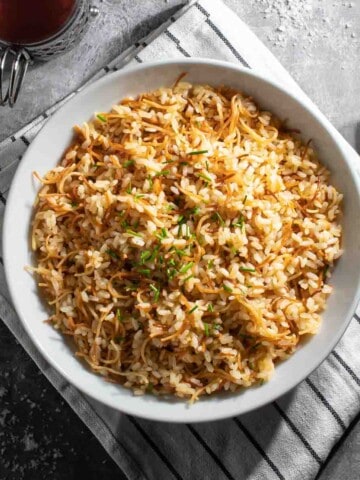
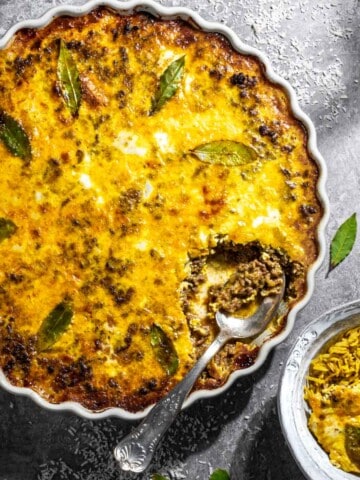

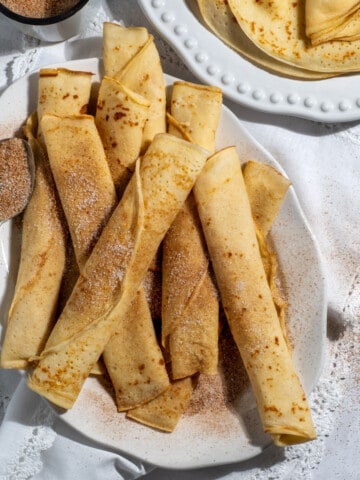


Leave a Reply